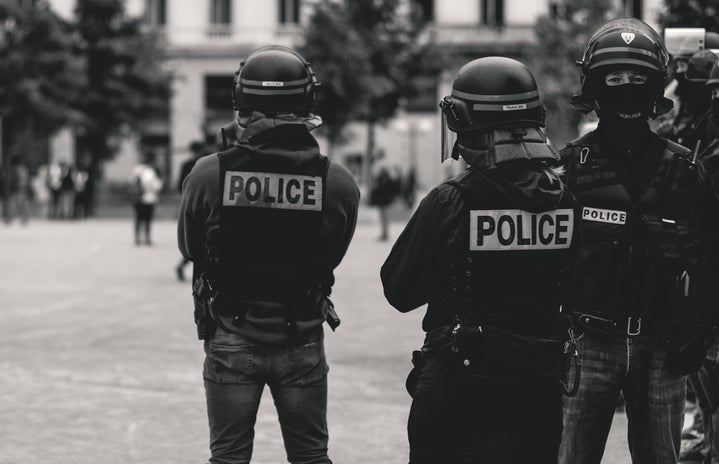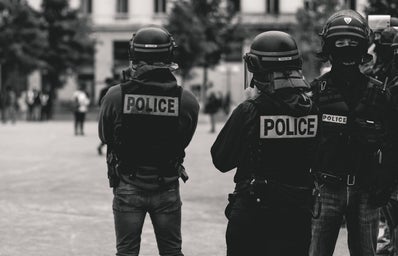At a Black Lives Matter protest in Seattle, Washington, a police officer sprayed mace in the eyes of a 10-year-old girl. At another protest, a police officer pulled off a woman’s hijab. At another, a policeman kicked a pregnant woman in the stomach; she later miscarried. Hundreds of officers fired rubber bullets at and used tear gas against peaceful protesters. None of these actions by the police were necessary. None of these actions were taken to protect the people.
It is important to remember why these protests are occurring in the first place: to raise awareness about, speak out against, demand justice for, and prevent the unlawful murders of Black Americans by police officers. Given their actions, it is fair to say that many officers are failing to do their jobs and are abusing their authority. In an effort to understand why this is happening, social psychology experiments such as the Stanford Prison Experiment and the Milgram Experiment may offer an explanation.
The Stanford Prison Experiment
The Stanford Prison Experiment, conducted by Philip Zimbardo in 1971, aimed to understand the power dynamic between prisoners and prison guards. There were 24 participants, all of whom were male college students living in and around the Stanford University area. A coin toss divided the participants into two groups: “prisoners” and “prison guards.” The participants who were labeled “prisoners” were treated as though they were true prisoners. They were strip-searched upon entry, forced to wear a prison uniform, and were only referred to by their prison ID number. The “guards,” on the other hand, were simply made aware of the dangers assuming their role may have for them and were instructed to do whatever they deemed necessary to maintain the order within the prison.
The situation rapidly shifted from order to chaos. Guards began to abuse their power almost immediately after being given a badge and a uniform. Prisoners were woken up at random hours and were forced to repeat their ID numbers over and over again. They were required to do push-ups when ordered while a guard sat or stepped on their backs. In the guards’ eyes, the prisoners were dangerous, vengeful, and threatening, causing them to exercise increasing levels of control over the prisoners as the experiment progressed. They soon began to govern every aspect of the prisoners’ lives by imposing a bedtime, placing restrictions on when a prisoner could use the bathroom, and separating them into “good” and “bad” cells based on their behavior. The guards even had conversations about how they could inflict further “psychological torture” upon the prisoners, despite the fact that the prisoners were already being compliant with their demands. Many of the prisoners left early on in the experiment and the study itself was cut short after a mere six days due to the psychological trauma and the physical abuse the participants endured.
The Milgram Experiment
The Milgram Experiment was conducted by a Yale psychologist in 1961 to understand the discord between one’s conscience and one’s adherence to authority. There were 40 participants, all of them men that had volunteered to be a part of the study. When each participant entered the laboratory, a shock generator with shock levels ranging from 30 volts to 450 volts sat before them. The researcher in the room told each participant that he was to be the “teacher.” This “teacher” was instructed to read questions to a “learner” who sat in another room and could not be seen by the “teacher.” If the “learner” answered incorrectly, the “teacher” was required to administer a shock to the “learner,” which increased in voltage with each incorrect answer.
The “learner” was not actually shocked and was directed to answer incorrectly; however, this information was unknown to the “teacher,” causing them to believe they were truly harming another individual. Throughout the study, the “learner” became more vocal about the shocks they were receiving. They would yell, cry, scream about having a heart condition, beg to leave, and refuse to answer questions. Refusal to answer was considered to be an incorrect answer, and thus the “learner” was shocked for their reluctance to respond.
Most of the “teachers” asked the researchers whether or not they should continue with the experiment given the “learner’s” pleas. The researchers were required to give one of four responses: “please continue,” “the experiment requires you to continue,” “it is absolutely essential that you continue,” and “you have no other choice but to continue.” Despite their concerns for the safety and well-being of the “learner,” 65% of the participants continued administering shocks until the highest level was reached. 100% of the “teachers” administered a shock of 300 volts. These results tell us that in situations in which one has authority and is given instruction from a higher source, one’s own sense of morality will likely be ignored. This phenomenon remains true even in cases when employing power and following commands may be fatal for others.
Relation to Acts of Police Brutality
The parallels between the Stanford Prison Experiment, the Milgram Experiment, and our police system are disturbing, to say the least.
The police system, since its inception, has taken everyday civilians and transformed them into protectors of the people and enforcers of the law. In doing so, these individuals are placed into positions of high authority. They are taught to believe that they are above the law and that they can exercise their control to the fullest extent. They learn to believe that they are superior to others because of the jurisdiction they are given. This superiority complex fuels the blatant disregard for human life some police officers display while on the job. They use excessive force and unnecessary violence when dealing with innocent people because they are in a position of power and are backed by a higher authority who accepts these actions and protects them by way of the law.
This same system was utilized largely during the Jim Crow era, a time in which segregation and racism prevailed throughout the nation. False ideologies about marginalized groups, namely Black Americans, were widely held by many, fostering a sense of hatred and intolerance from white Americans toward Black Americans. Police officers were used as instruments of the government to preserve and to reinforce racial discrimination and racial divisions between these groups.
There has been little to no change in how police officers train and function since the Jim Crow era. In fact, police officers spend a mere eight hours on “mediation/conflict management” and as little as four hours on “hate crimes/bias crimes” during training. The majority of their time is dedicated to developing their “firearms skills” and “self-defense” skills. This is deeply problematic for the reason that police are receiving little to no training on managing the conflict, hatred, and biases that tend to emerge during their work. They are, instead, learning how to use firearms and other violent defense mechanisms to stop the crimes they witness and to handle the individuals they encounter.
The Stanford Prison Experiment shows us that when placed into a position of authority, the power an individual is given will inevitably be abused in some way, shape, or form. By giving police officers a badge, gun, and uniform, they are provided with an extreme amount of power over human life. When placed into a system that was founded upon restricting the freedoms and controlling the livelihood of marginalized groups, a mob mentality is formed. This mob mentality is similar to the one observed in the Stanford Prison Experiment, in which innocent people who complied with the demands of an authority were subjected to extreme psychological and physical abuse. Because the police view these innocent people as beneath them, and regard them as criminals because of racist stereotypes, some police officers feel as though it is acceptable and necessary to use violence to display their power, control, and superiority.
The Milgram Experiment illustrates that some police will compromise their own sense of morality and resort to using excessive force if instructed to do so by an authority figure. Police are agents of the government that exist to maintain order and enforce the laws established within our society. They are permitted and encouraged to use force when they feel it is necessary. When this violence goes to the extremes and costs an innocent individual their life, the police officers are able to escape punishment because both the government and the law are there to protect them.
If police officers who have participated in acts of violence against innocent civilians are not held accountable for their inhumane actions, they will continue to believe that their views and actions are right. They will continue to push the limits of their authority if our leaders instruct and their colleagues allow them to, time and time again. Their behavior will remain unchanged because no one is holding them accountable for their actions and no one is telling them they cannot act in these ways.
I want to make one thing clear. I do not mean to say that all police officers are inherently bad people. Instead, I mean to say an individual may abuse their power or overlook their own morals when placed into a position of authority and when directed to by a higher command. I encourage you to use your voice and your platform to denounce the criminal actions of these police officers. I urge you to donate to organizations actively working to combat police violence (examples include Campaign Zero, Communities United for Police Reform, and National Police Accountability Project) and to the families of the victims of police brutality. Educate yourself. Listen to the Black voices in your community. Sign petitions. Do what you can to make a change.
Further information on how to help can be found on this website.


